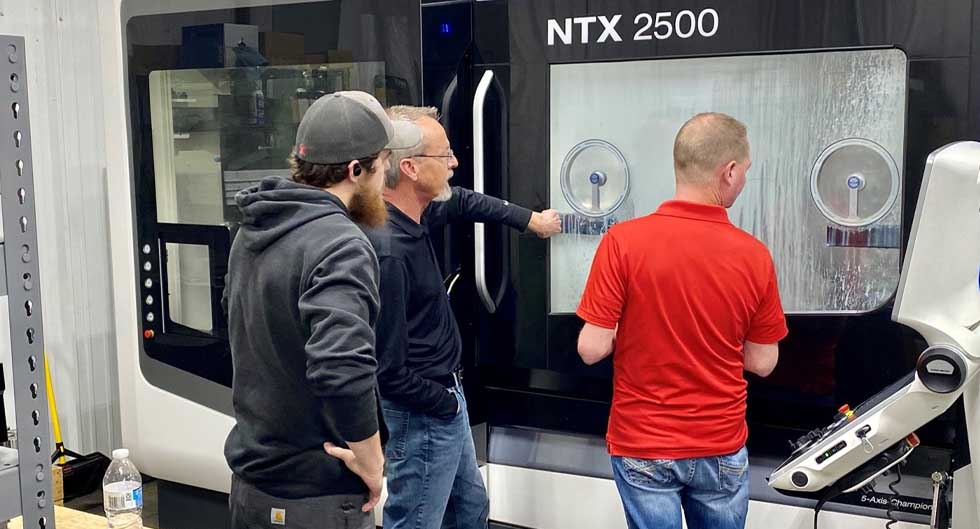It’s Neither a Mill Nor A Lathe
Keith Felts, President of Advanced Machining (shown center above with Advanced CNC programmer/machinist Brandon Edds on left and R&D Machine VP & General Manager Justin Kovscek on right), started his company in 1985 after serving as an application engineer for a leading machining equipment manufacturer. Along the way, he became extremely knowledgeable of precision machining technologies. Shortly before Compass acquired Advanced in October 2019, he purchased his first mill/turn machine, a NLX 2500 model from DMG Mori. Compass has since invested in six additional advanced mill/turn units, including Advanced’s NTX 2500 unit pictured above. In total, the company has fifteen mill/turn machines, including twelve at Douglas Machining and two at Gray Manufacturing as well as the three at Advanced. We recently visited Keith and discussed multi-tasking mill/turn machining. Here is what we learned:
How Can A Machining Center Be Neither A Mill Nor A Lathe?
That’s because it is both. A mill/turn machine like the ones Compass has allows for chip removal via both milling and turning in one setup on a single machine. With the mill/turn process, these machines perform both milling and turning by selectively rotating the workpiece and cutting with a stationary tool (i.e., turning) followed or preceded by holding the workpiece stationary and engaging it with a rotating cutting tool (i.e., milling).
What Are The Advantages of Mill/Turn Machining?
The mill/turn process can manufacture parts requiring both traditional lathe and mill work in a single setup, or with a significantly reduced number of setups for very complex parts. This is extremely advantageous for numerous reasons. Each setup is costly in terms of downtime, plus potential operator error is introduced every time a workpiece is refixtured. In addition, cycle time is usually reduced in a mill/turn machine versus making the same part in separate milling and turning operations. And of course, leadtimes are often shortened as well because of fewer ops and less actual machining time. Everybody wins.
But Aren’t Mill/Turn Machines Expensive?
Yes, a mill/turn unit typically costs more than an individual mill or lathe. That’s probably why every shop doesn’t have one. But for leading manufacturers like Compass who understand return on investment, buying and operating mill/turn machines is an optimal way to make parts having both milled and turned features.
Are There Other Capabilities of Mill/Turn Machines That Are Advantageous?
Absolutely. Many mill/turn units are equipped with dual spindles. On these machines, the workpiece can be passed from one spindle to the other during the same operation, with both ends of the part being machined without operator intervention. A dual spindle machine can also be set up to cut two parts, potentially for two different customers, during each machining cycle.
I Have Heard That Some Mill/Turn Machines Also Have Twin Turrets. What Is That?
The machines you are referring to are equipped with dual turrets. This means that the work pieces in each spindle can be machined separately and concurrently. Some machines, like our NTX 2500, achieve this same capability by using a single turret plus a 5-axis milling head that can hold turning tools. This is a huge advantage, particularly when the two cycle times are approximately equal. Much greater production can be achieved with a small footprint and reduced labor input.
What Challenges Did You Encounter When First Getting Into Mill/Turn Machining?
In addition to higher capital costs, the other main downside to mill/turn is more complicated CNC programming. This is because more things are going on at the same time, plus the programmer needs to be competent with both milling and turning. We have invested heavily in training our CNC programmers to overcome these challenges. In addition, we use simulation software to understand tool paths before the first chips are cut.
Finally, What Should Customer Know About Mill/Turn Operations
If you need parts that combine turned and milled surfaces, the most optimal way to manufacture these parts is probably through the use of multi-tasking mill/turn machines. Many shops in this country are still machining components like these through a series of discrete operations involving both mills and lathes. If this is what your vendor is doing, then I suggest you seek out an alternate vendor with mill/turn machines. Your leadtime, quality, and costs may all improve as a result of the natural advantages of mill/turn machining we just discussed.
For additional information about Advanced Machining’s experiences with multi-tasking mill/turn machines, please feel free to reach out to Keith Felts directly at [email protected]. For general info on Compass and its various shops, or to request a quotation, please contact Compass VP of Sales Jim Miller at [email protected].


